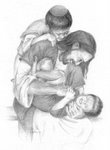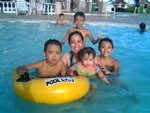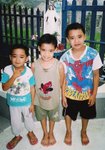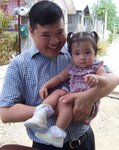Re: Filipino Coping Mechanisms
Fr: Laigo BL, Cura NM, Oreta JS, & Galang GP (2004). Indicators of family wellbeing. Manila: Philippine Women’s University, pp. 18, 21-26, 38-40 (caps mine).
A. Respondents
METHOD | RESPONDENTS | LOCALITY | SEX | AGE | SES | RELIGION |
Focused Group Discussion | 231 Parents | Luzon, Visayas, & Mindanao | 27% male + 72% female | mean = 40.8, range = 17-73 | Mostly economic class C or D, except for the Paraňaque group (class B) | Mostly Christian (including Manobos of Davao, dominated by Catholics), except for Muslim couple & Imam & Aetas of Pampanga |
| 57 Children | Tarlac, Pampanga, Batangas, & Iloilo | 54% male + 46% female |
| ||
Written Survey | 132 Children | Manila, Laguna, Cavite, & Davao | 42% male + 58% female | mean = 14, range = 10-18 | ||
Oral Survey | 1 Muslim Couple + 1 Imam |
|
|
| ||
TOTAL | 423 (234 Adults + 189 Children) |
|
|
|
B. Results
1. 1.Support System
>”… when confronted with financial or other family problems, the family would rely on the relatives or the neighbors for assistance.” (p. 38)
>”For instance, an unwed pregnant woman finds support in her family when they accept the child born out of wedlock as part of the family.” (p. 38)
>”Neighbors become an extension of the family and are expected to provide social support.” (p. 38)
-- Example: neighbors are asked to informally look after the children when not around (“silipin” or to “take a peek”), neighbors immediately report child’s misdemeanour to parents
>Citation: “The Filipino is clannish and expects to be morally, socially, and financially supported in many ways by his immediate as well as extended family. Thus, the family becomes the REFUGE and SHELTER of a person at good and bad times” [Jocano, L. (1998). Filipino social organization, traditional kinship and family organization. Manila: Punlad Research House, p. 63.]
>Related Study: “In the Go study (1995) [Go. S. (1993). The Filipino family in the eighties. Manila: Social Development Research Center, De La Salle University – Manila], urban poor mothers said they usually ask help from a great number of people such as their siblings, friends, relatives, employer, in-laws, co-workers, owners of small-variety stores, and members of the community organizations as part of the INFORMAL SYSTEM. They also seek help from nuns, the police, government authroties (for [pp 38/39] issues concerning demotions), health center, and other FORMAL SYSTMES like, TV show personalities like “Mel and Jay,” “TV Patrol,” and “Kapwa ko Mahal ko”.
“Based on Go’s study, seventy-five percent (75%) of the URBAN POOR mothers stated that they were satisfied with the support system provided by the informal and formal systems, twenty-five percent were not satisfied” (p. 39).
2. 2.Religion and Faith
>…the phrase ‘nasa Diyos and awa, nasa tao ang gawa” (God is merciful, but man must do his part) was a common response used by the parents, giving the impression that resorting to religion and faith is how they cope in times of difficulty or during crisis situations. In fact, PRAYING has often been resorted to whenever they are in trouble. “Magdasal sa Dios pag may problema” (pray to God when there is a problem). Perhaps as a Christian nation, praying is PART OF THE FILIPINO PSYCHE since we have been taught to perceive God as merciful. But this behaviour of turning to prayers and God is more apparent … during times of distress” (p. 39).
3. 3.Humor
>”… the sense of humor of the participants was [pp. 30/40] evident, becoming an INTEGRAL PART of their storytelling, laughing at the problems they shared as wife and mother, and diffusing the seriousness of the discussion.” (pp. 39-40)
>Citation: “Humor as a way of coping has also been observed among Filipinos.” (paraphrased form: The Committee Report: Building a People, Building a Nation: A Moral Recovery Program. In Acuňa, J., Rodriguez, R., & Pilar, N (Eds.). Readings in human behaviour in organization. Quezon City: Diwata Printing.)
















